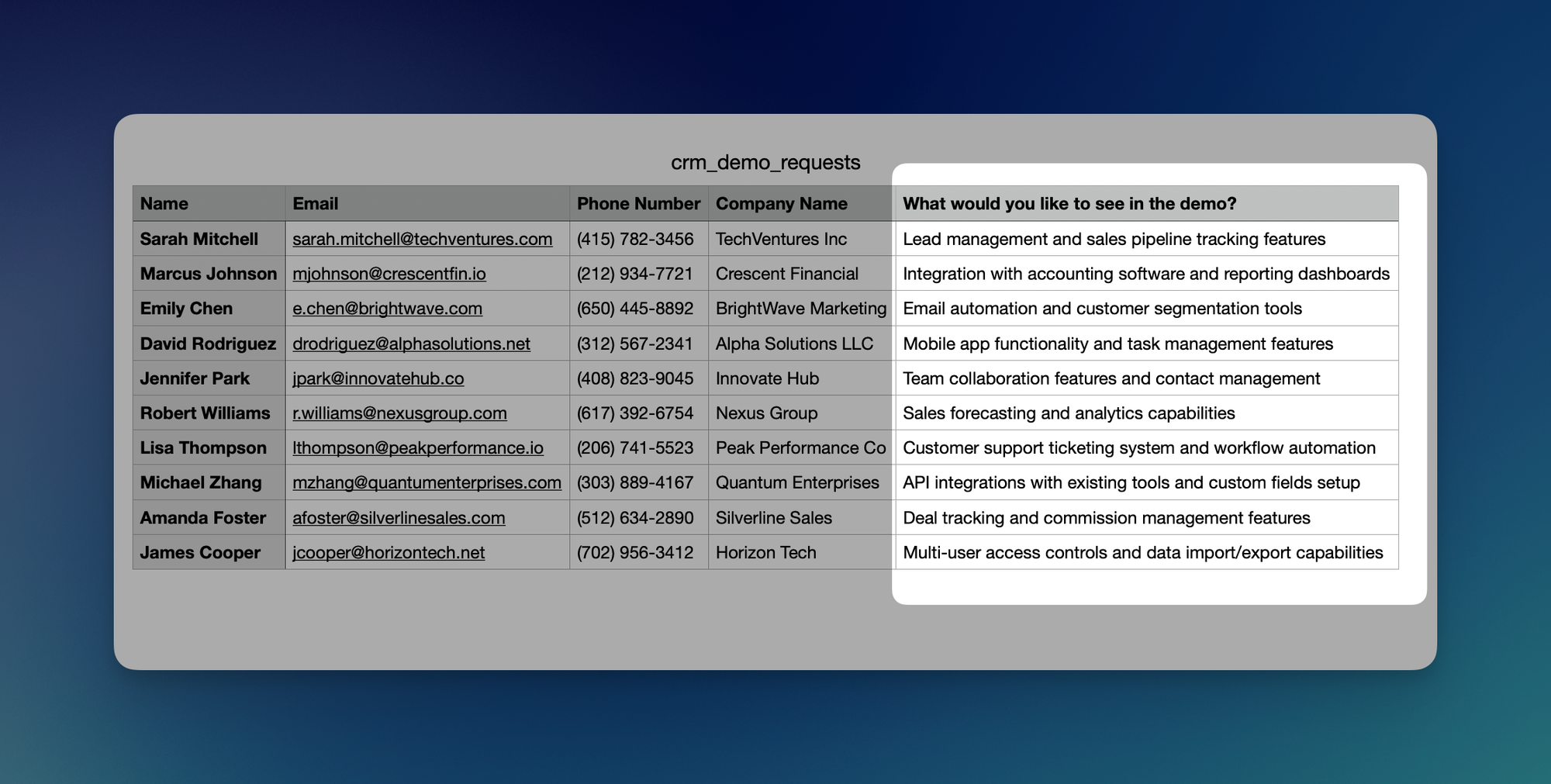SEO Keyword Research Guide 2025: Tools, Techniques & Best Practices
This 2025 guide reveals proven techniques and tools for uncovering valuable keyword research, from free methods using Google Search Console to advanced competitor analysis with platforms like Ahrefs and SEMrush
The Alchemy of Keywords: A Window into the Customer’s Soul
There’s something almost mystical about keywords—they are the quiet, unassuming architects of digital desire. With nothing more than a few taps on a keyboard, a customer reveals not just what they want, but who they are: their anxieties, their ambitions, their unspoken longings.
For the first time in the long, noisy history of commerce, we have something approaching a direct line to the collective consciousness of consumers. No focus groups, no surveys, no guesswork—just the raw, unfiltered truth of what people type into a search bar, captured in real time, aggregated into data, and transformed into insight.
In this new landscape, the search box is more than a tool—it’s a confessional.
Most marketers, however, treat keywords as mere tools—functional, utilitarian, a box to check in the grand machinery of digital advertising. But to dismiss them as such is to overlook their true power.
Keywords are the foundational atoms of modern digital marketing, the building blocks of connection in an age where attention is the rarest currency. They are not just words; they are confessions, whispered into the void of the internet, waiting to be heard. And for those who know how to listen, they offer something unprecedented: a glimpse into the hearts and minds of customers, unmediated and unvarnished.
Why Keyword Research Is the Backbone of B2B Digital Marketing
Let me cut to the chase: If you’re investing in B2B companies, keyword research isn’t just a tactical SEO exercise—it’s the difference between a product that resonates and one that disappears into the noise. After two decades in B2B marketing, I’ve seen firsthand how the companies that dominate their categories don’t just stumble into success. They engineer it, starting with the data hidden in plain sight: what their customers are actually searching for.
1. Keyword Research & SEO: Own the Conversation Before It Starts
The most obvious play is SEO, but most teams still treat it like a checkbox. Here’s the reality: Keyword research isn’t about guessing what your audience wants—it’s about knowing. You get the search volume (how many people are looking for this, monthly or annually), the geography (where demand is concentrated), and, most critically, the intent behind the search. Are they researching a problem? Comparing solutions? Ready to buy?
With this data, you don’t just create content—you build a strategic asset. Landing pages, blogs, and videos aren’t shot in the dark; they’re precision-engineered to rank for the exact terms your buyers use. The result? When a prospect searches for a solution, your company isn’t just in the conversation—it leads it. And especially in B2B, where sales cycles are long and trust is everything, visibility at the right moment is worth its weight in pipeline.
2. Keywords Research & Paid Ads: Spend Smarter, Not Harder
Google Ads isn’t a casino—unless you treat it that way. Keyword research tells you three things that separate profitable campaigns from money pits:
- Intent: Are they looking for education, comparisons, or a vendor?
- Volume: Is the demand real, or are you chasing a niche that doesn’t move the needle?
- Cost: What’s the CPC, and is the ROI justified?
I’ve seen companies burn through six-figure ad budgets targeting broad, expensive keywords with no intent behind them. Meanwhile, the winners? They’re bidding on the specific terms their ideal customers use—often at a fraction of the cost. Keyword data lets you allocate spend like a portfolio manager: high conviction, high return.
3. Keyword Research & Product Marketing: Speak the Customer’s Language—or Lose
This is where most B2B companies fail. They assume they know how customers describe their problems and the solutions they need. They’re wrong.
Keyword research reveals the exact language prospects use. For example:
- The Problem: “How to scale customer support without hiring”
- The Solution: “Best help desk software for SaaS companies”
- The Nuance: “Open-source AI ticketing system”
In this guide, we’ll explore the most effective techniques, tools, and processes available for uncovering valuable keyword insights.
TL;DR: Keyword Research Tools & Techniques
- Search Engine Autocomplete ("People also search for"): Using Google, Bing, or DuckDuckGo to find related queries.
- Kagi Search Engine for Developers: A search engine that provides all the listicles based on any search term, and removes "SEO nonsense."
- Google Search Console: Analyzing your site's search performance and impressions to find keywords.
- Long-Tail Keyword Analysis: Using regex in Google Search Console to find specific, long-phrase keywords.
- Google Trends: Discovering trending topics and related queries.
- AI Chat Tools (e.g., ChatGPT, Claude, Mistral): Asking an AI to generate a list of top keywords.
- Google Ads Keyword Planner: Getting search volume and related keyword ideas.
- AnswerThePublic.com: Finding questions and prepositions people search for around a topic.
- Ahrefs (and similar tools like SEMrush, Moz): For advanced keyword research, competitor analysis, and finding forum discussions.
- Sales Call Analysis: Using AI transcription tools (like Fathom) to extract keywords from customer conversations.
- Contact/Demo Form Analysis: Analyzing text from CRM forms to find common words and phrases prospects use.
The Easiest Way to Do Keyword Research—Using Just Your Search Engine
The easiest way to do keyword research without any third-party tools, without signing up for or paying for any other tool, is just your search engine.
So, whatever keyword you want to explore, if you have a rough idea of what to call your product or service, or of what your prospect would ideally search for, then just do the most natural thing, which is to enter or input the keyword in the search box. If you scroll down, you will find a section called "People also search for," which lists all the related keywords you have entered in the search box. It will easily give you 8 to 10 keywords.
You can also do this for other search engines, such as DuckDuckGo and Bing.

Interestingly, there is also a search engine called Kagi, which is primarily focused on a developer audience. It also removes all the SEO nonsense and provides a list of all the listicles that someone is searching for.
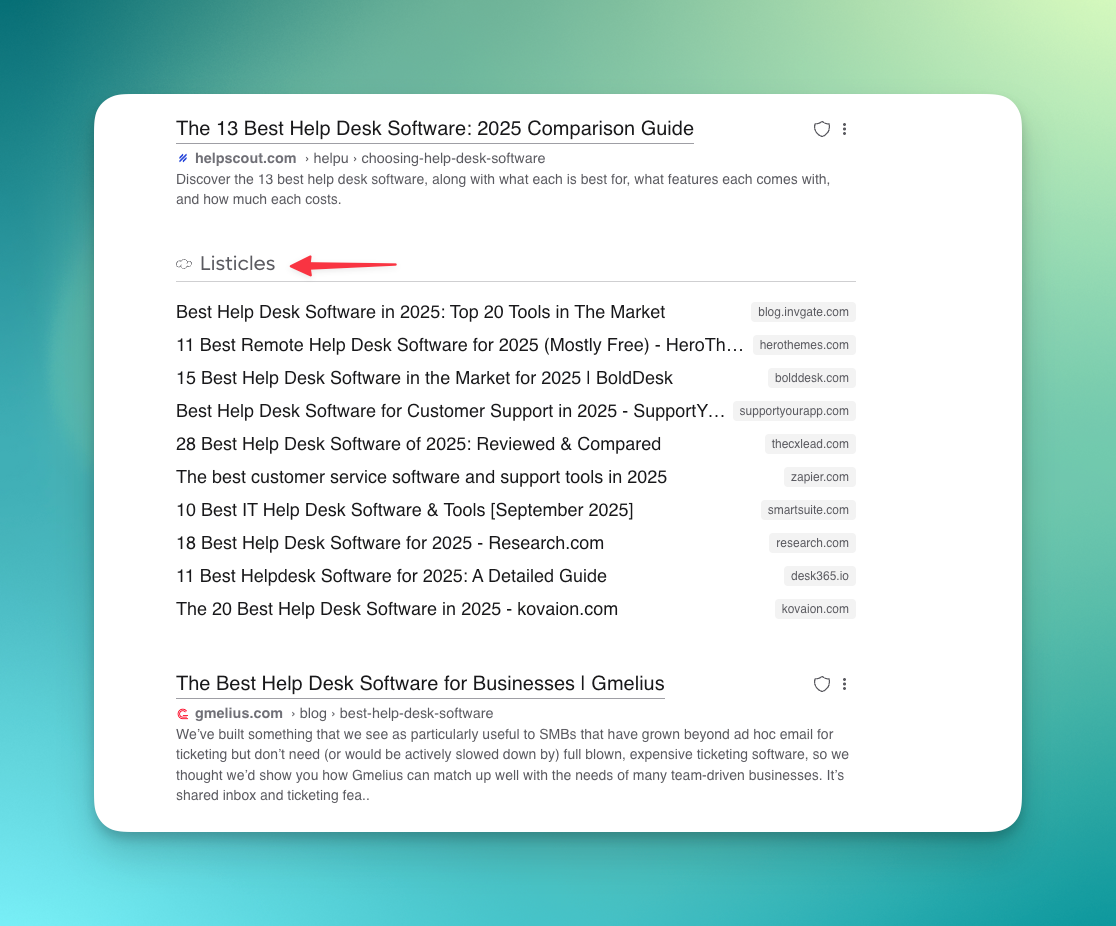
Keyword Research in Google Search Console
Google Search Console is a powerful tool that provides valuable insights into your website’s performance in search engines. If your website doesn’t have it set up, you’re missing out on essential data.
When it comes to keyword analysis, Google Search Console offers two key data points:
- Impressions: This shows the number of times your website or a specific page appeared in search results for a keyword. For example, if your keyword is “Help Desk Software,” and the tool shows 2,000 impressions, it means your website appeared in search results 2,000 times over a specific period—regardless of whether it was on the first, second, or third page.
- Clicks: This indicates how many times users actually clicked on your website after seeing it in search results for a keyword.
How to Use This Data for Keyword Research
To prioritize your SEO efforts, focus on keywords with high impressions but low clicks. This suggests that while your website is appearing in search results, it’s likely ranking too low (e.g., on the second or third page) to attract clicks. Optimizing these keywords can improve your ranking, increase clicks, and boost conversions.
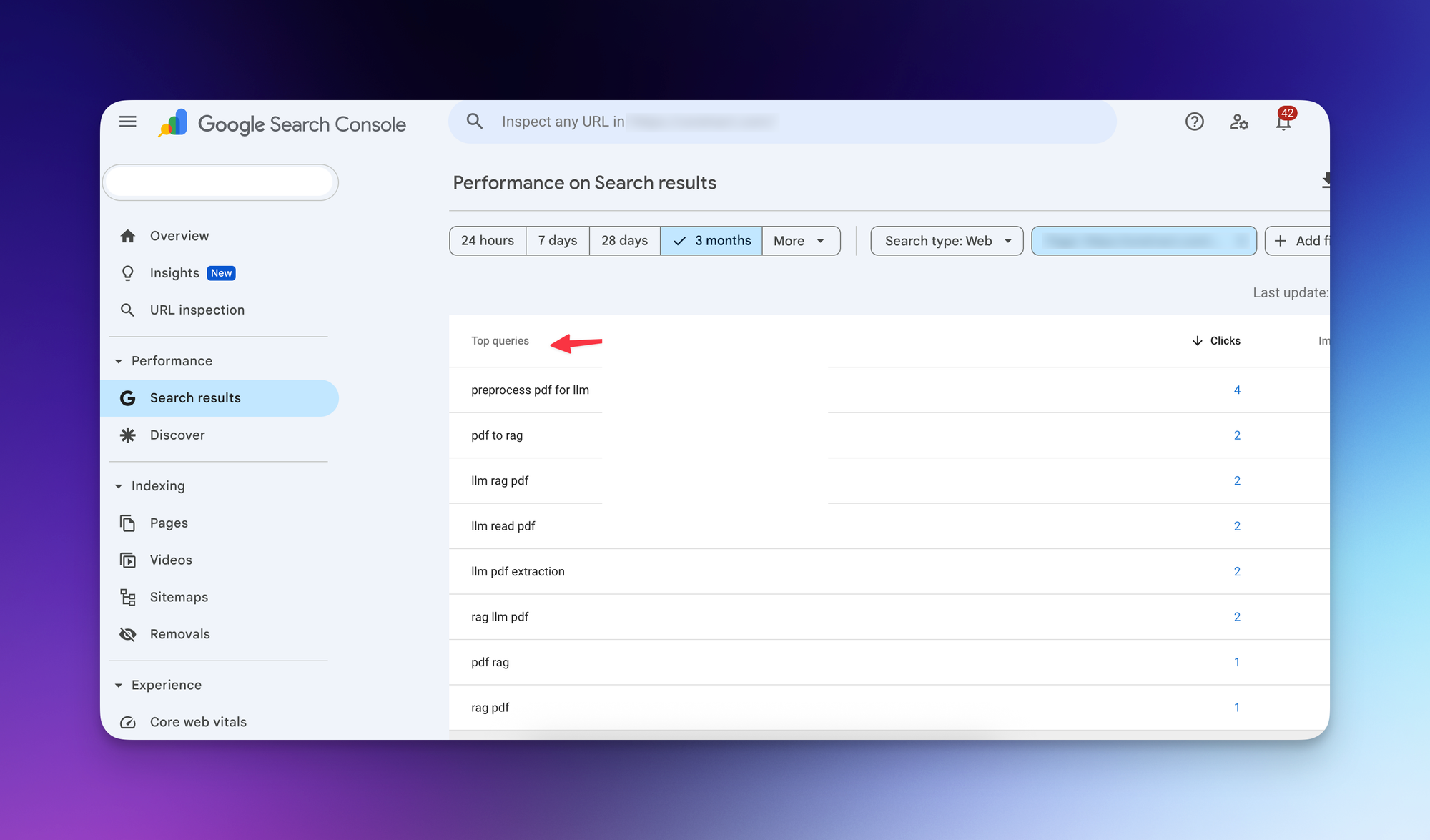
A Quick Detour: Analysis of Long Tail Keywords
Let’s compare two keywords:
- Helpdesk software
- Open source helpdesk software self-hostable in AWS
The second one is called a long tail keyword. Long tail keywords are more specific. For example, instead of searching for "Nike shoes," someone might search for "blue Nike shoes in Paris." This person is looking for something very specific.
Why Are Long Tail Keywords Useful?
- They show the exact intent behind a search.
- They are often easier to rank for, sometimes called "low-hanging fruit" for SEO.
- Tools like Google Search Console help you find and optimize for these keywords.
You can use the following regular expression to filter out long tail keywords, in this case keywords that contain more than four words.
^\s*(\S+\s+){4,}\S+\s*$
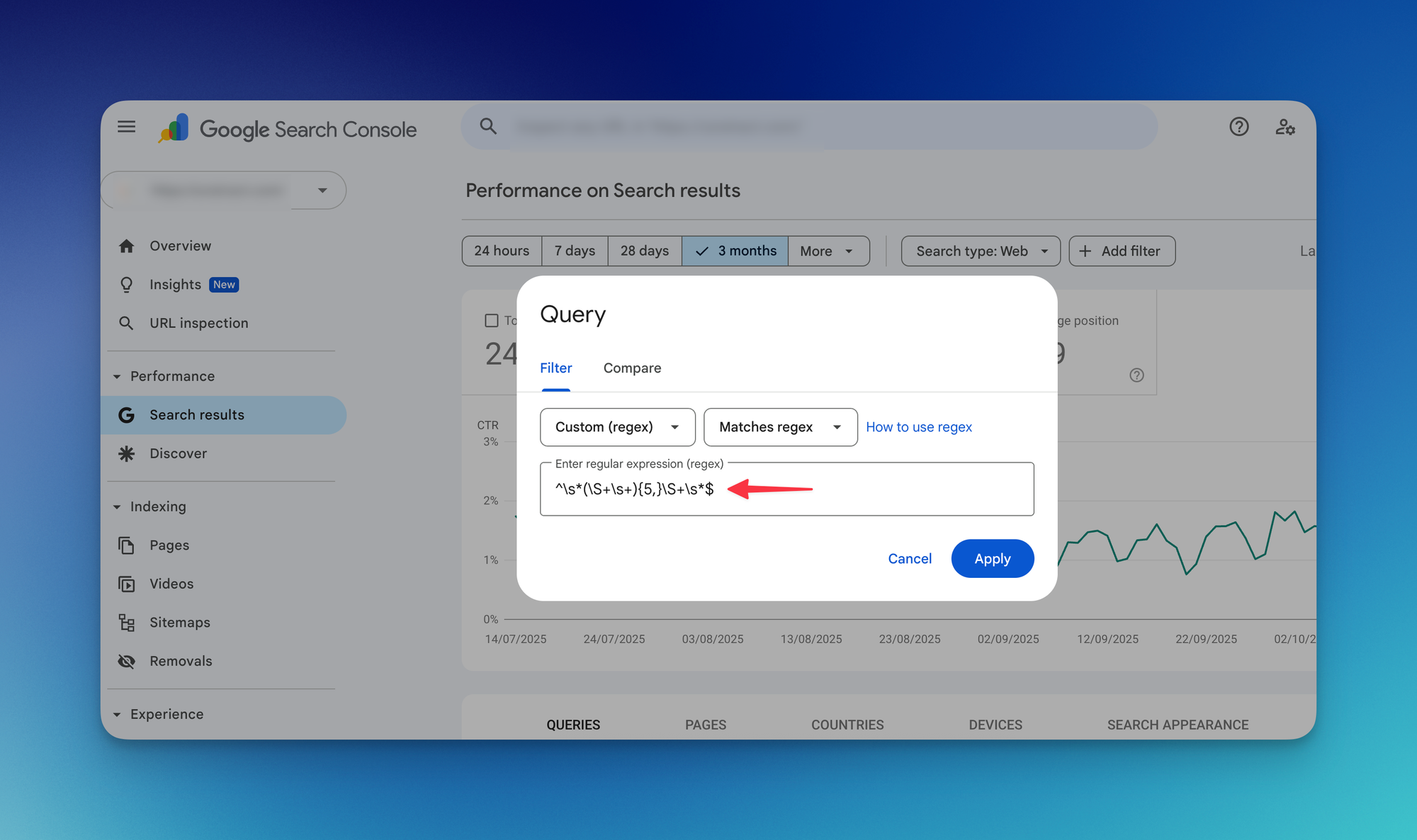

Google Trends for Keyword Research
Google Trends is a simple tool that helps you track how popular a topic, product, or trend is based on what people are searching for. For example, if you want to know what’s currently trending in sneakers, just type in a brand name. Google Trends will show you how interest in that brand has changed over time, giving you useful insights.
Using Google Trends for Keyword Analysis
To analyze keywords, go to Google Trends and enter your search term. Scroll down to find a section called "related queries." This section shows you the top 5 or 10 related searches for your term, along with how popular they are.
This is a great way to discover keywords that are in high demand, trending, or growing in popularity.

Using AI Chat Tools for Keyword Research
The easiest way to start with keyword analysis is to use any AI chat tool—like ChatGPT, Claude, or Mistral. Simply ask, "List the top 10 keywords for this product." The tool will research and provide you with a list. It’s quick, simple, and one of the easiest ways to do keyword research in 2025.

Google Ads Keyword Planner for Keyword Research
The next tool is Google Ads Keyword Planner, which is free to use. All you need is a Google Ads account to access it.
What Does It Do?
In simple terms, you can seed keywords related to your product, brand, or anything you want to promote. The tool will show you the list of other related keywords with the monthly search volume—the number of times people search for that keyword in a month.

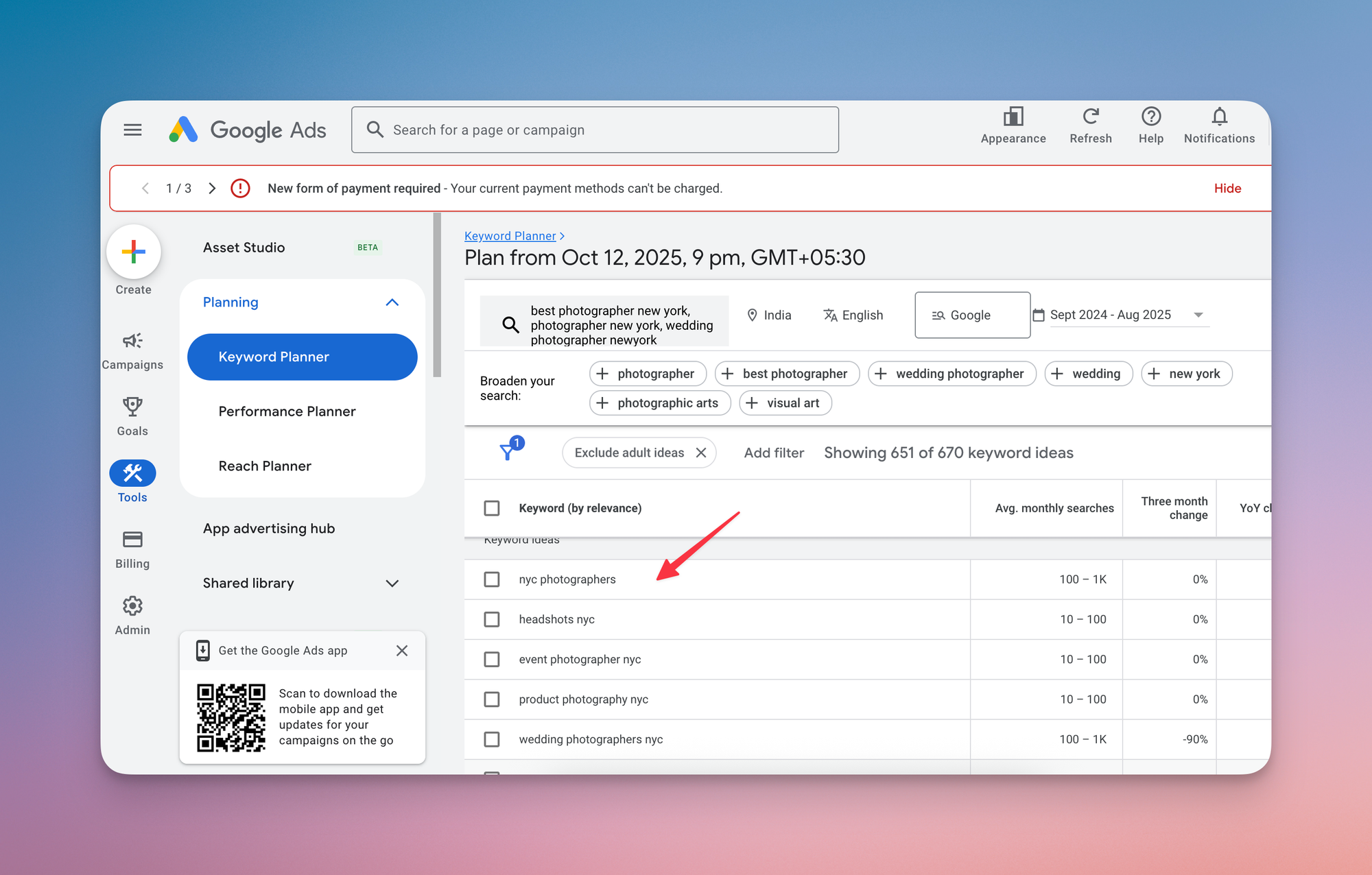
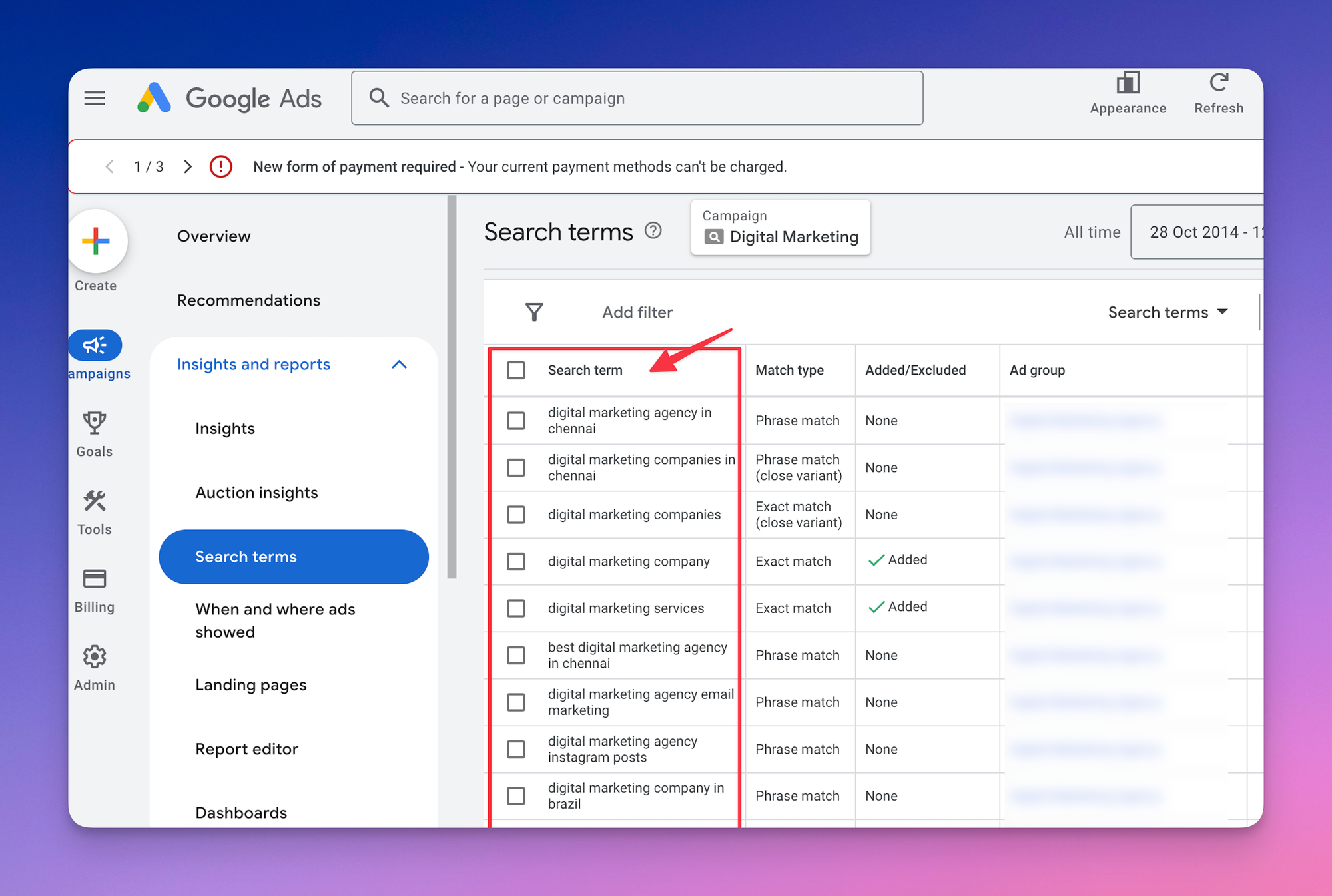
AnswerThePublic.com for keyword research
The next tool is AnswerThePublic.com. This tool works a little differently.
When you start typing a search term, search engines often suggest popular completions—like if you type "best Nike," you might see suggestions like "best Nike shoes" or "best Nike sneakers." AnswerThePublic taps into this data.
Just enter your keyword, and it will give you a list of related keywords that people are actually searching for.

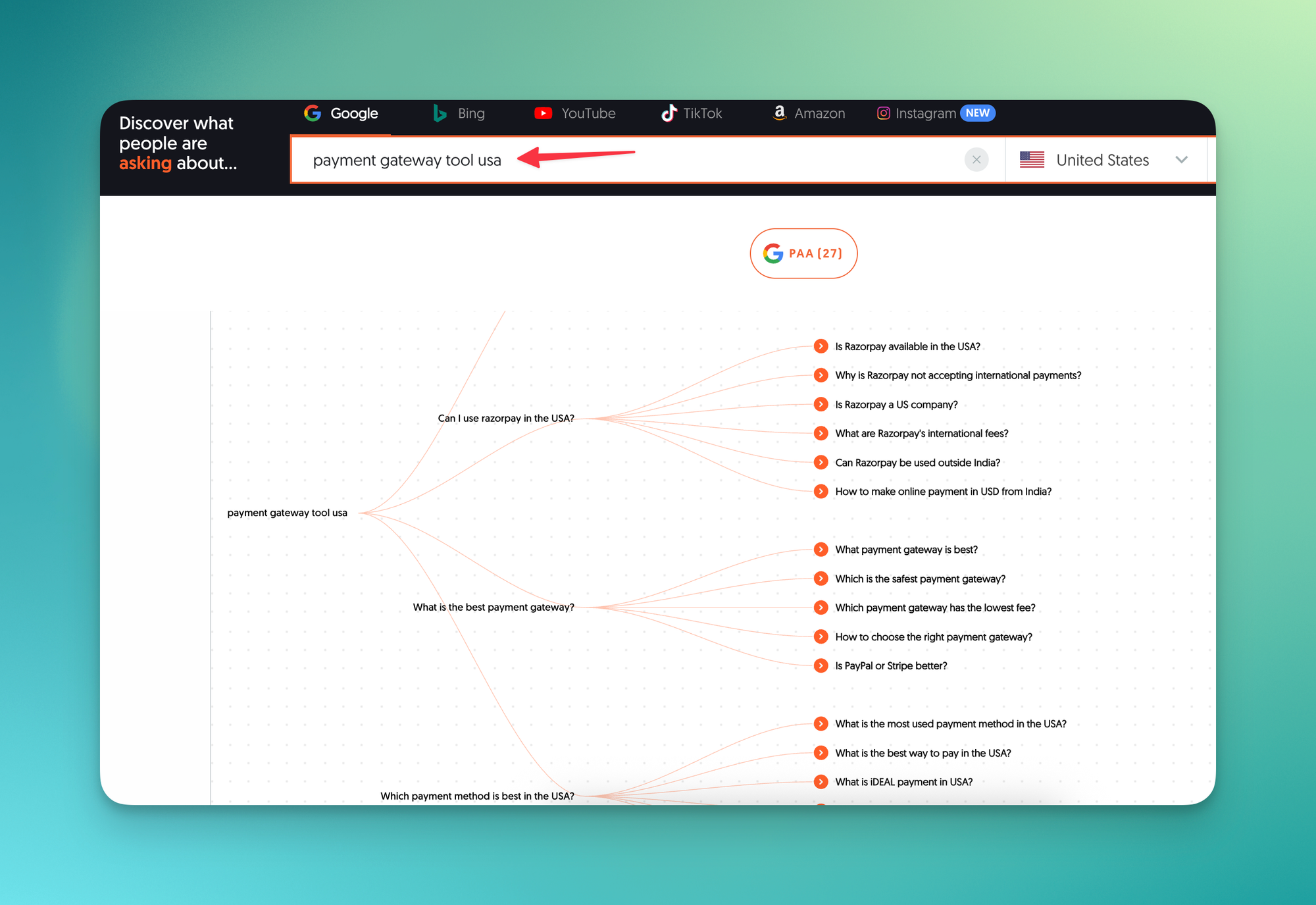
Ahrefs (and Similar Paid Tools) for Keyword Research
The next tool is Ahrefs—it’s a paid tool, but you can also use alternatives like SEMrush or Moz. Here’s how you can use these tools for keyword research:
1. Basic Keyword Research
Just like the free tools, enter/seed a keyword you’re interested in. Ahrefs will show you a list of related keywords that people are searching for.
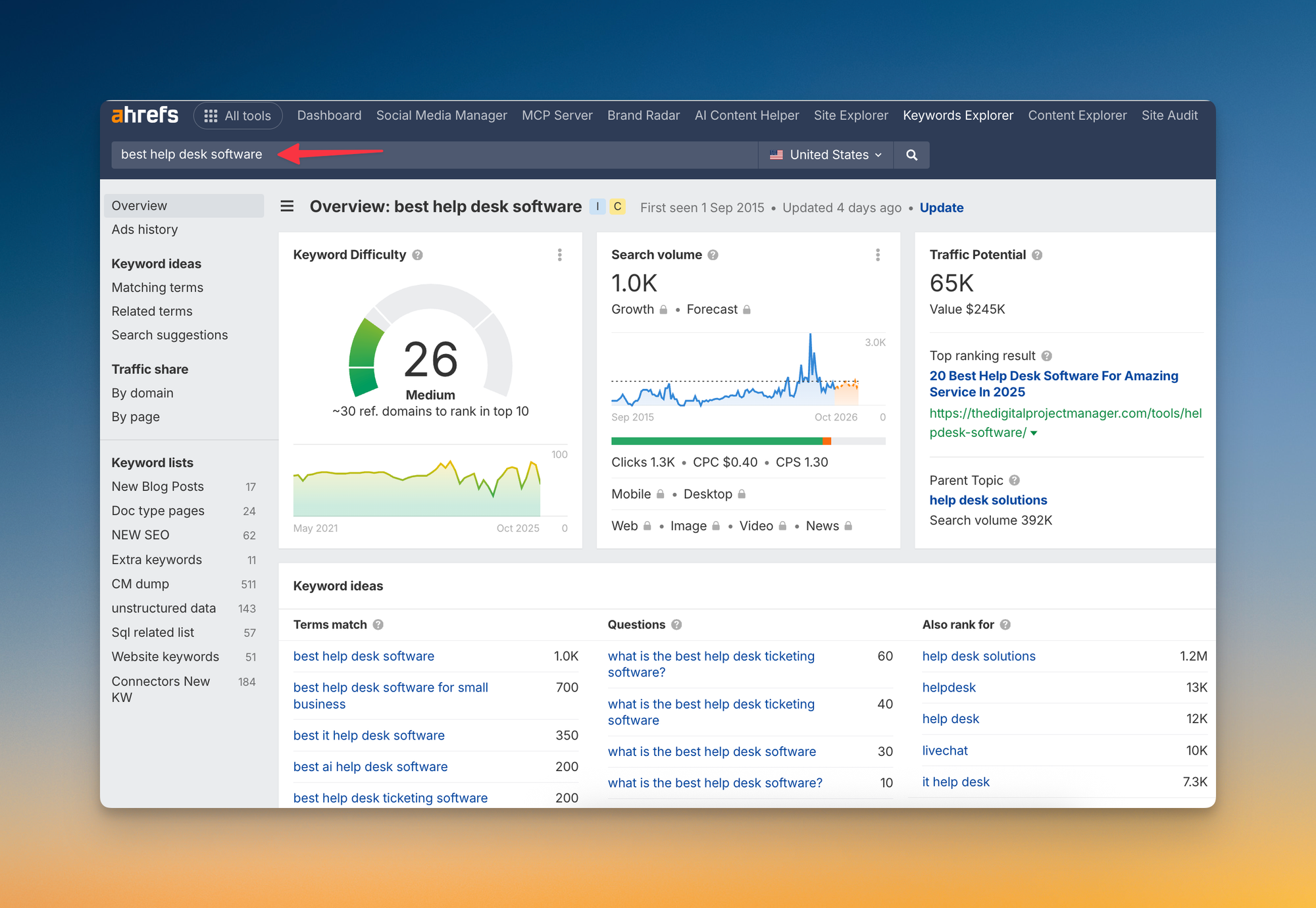
2. Keywords from competitor analysis
If you have a product, like a project management app, and a competitor like Asana, you can search for asana.com in Ahrefs. The tool will show you all the keywords Asana ranks for.
- You can analyze keywords at the domain level (entire website) or for a specific page.
- This gives you a list of keywords your competitors are ranking for, which you can target too.

3. Keywords from Public forums & discussions
You can also explore what people are talking about on public forums like Reddit or Quora.
- For example, search for reddit.com in Ahrefs and filter for keywords related to project management.
- This helps you understand what discussions, problems, or solutions your potential customers are searching for.
You can also check product community forums to see what people are discussing, what problems they face, and what solutions they seek.


4. Competitor Comparison
Pick two competitors, like Asana and Wrike, and compare their search performance.
- You can find keywords that one competitor ranks for, but the other doesn’t.
- This helps you see how each competitor is positioning itself and where you might find opportunities.

Using Sales Calls for Keyword Research
Listening to sales calls is a great way to find important keywords. A few years ago, reviewing hundreds of 45-minute calls was tedious. But now, AI-powered call transcription tools make it easy.
- These tools automatically transcribe calls and highlight key points, questions, and important details in a concise format.
- Some tools, like Fathom, even let you ask questions about the transcript. For example, you can prompt the tool to find all the keywords related to customer problems or the solutions they want.
- You don’t need to listen to the entire call—just ask the tool, and you’ll get the insights you need in seconds.
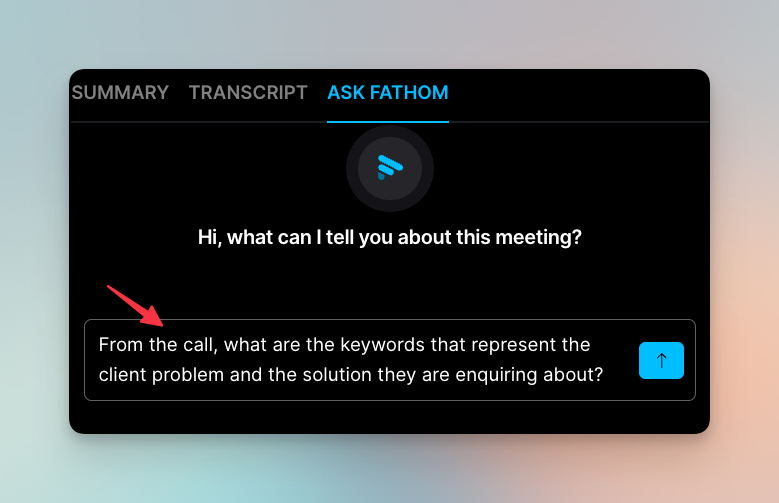
Using Contact/Demo Request Forms for Keyword Insights
Most B2B SaaS companies have forms where prospects can describe their problems, needs, or what they’re looking for in a product. These forms often include a text box for details.
- If you have hundreds or thousands of these form submissions, they’re a goldmine of information—like hearing directly from customers about their exact needs.
- This data is usually stored in your CRM or backend database. If it’s in a CRM, you can easily export it as a CSV file.
How to Analyze This Data
Once you have the data, you can analyze it in simple ways:
- Use a word cloud tool (or create your own) to spot the most common words and phrases.
- This helps you understand the intent and keywords prospects use to describe their problems and needs.
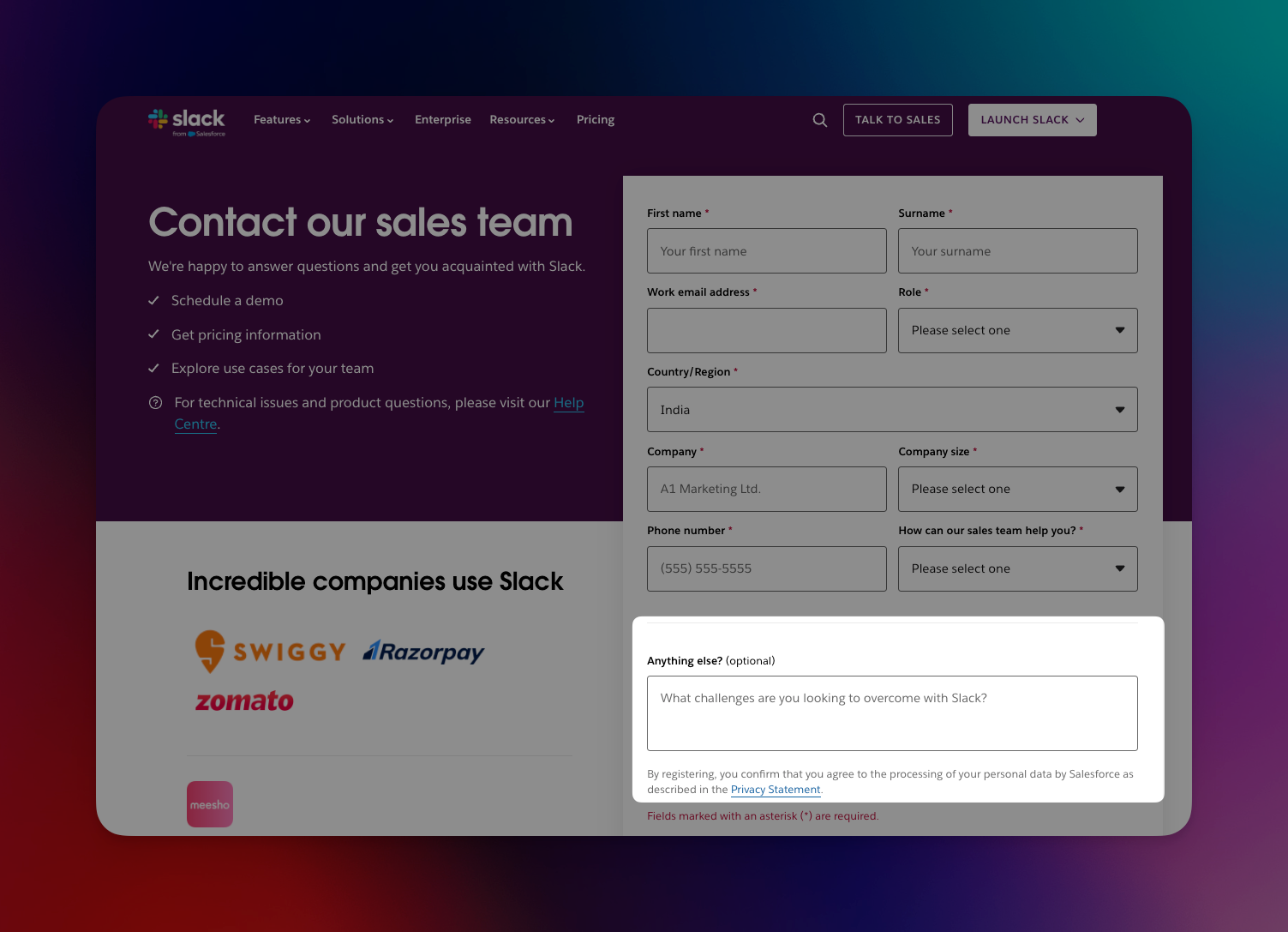
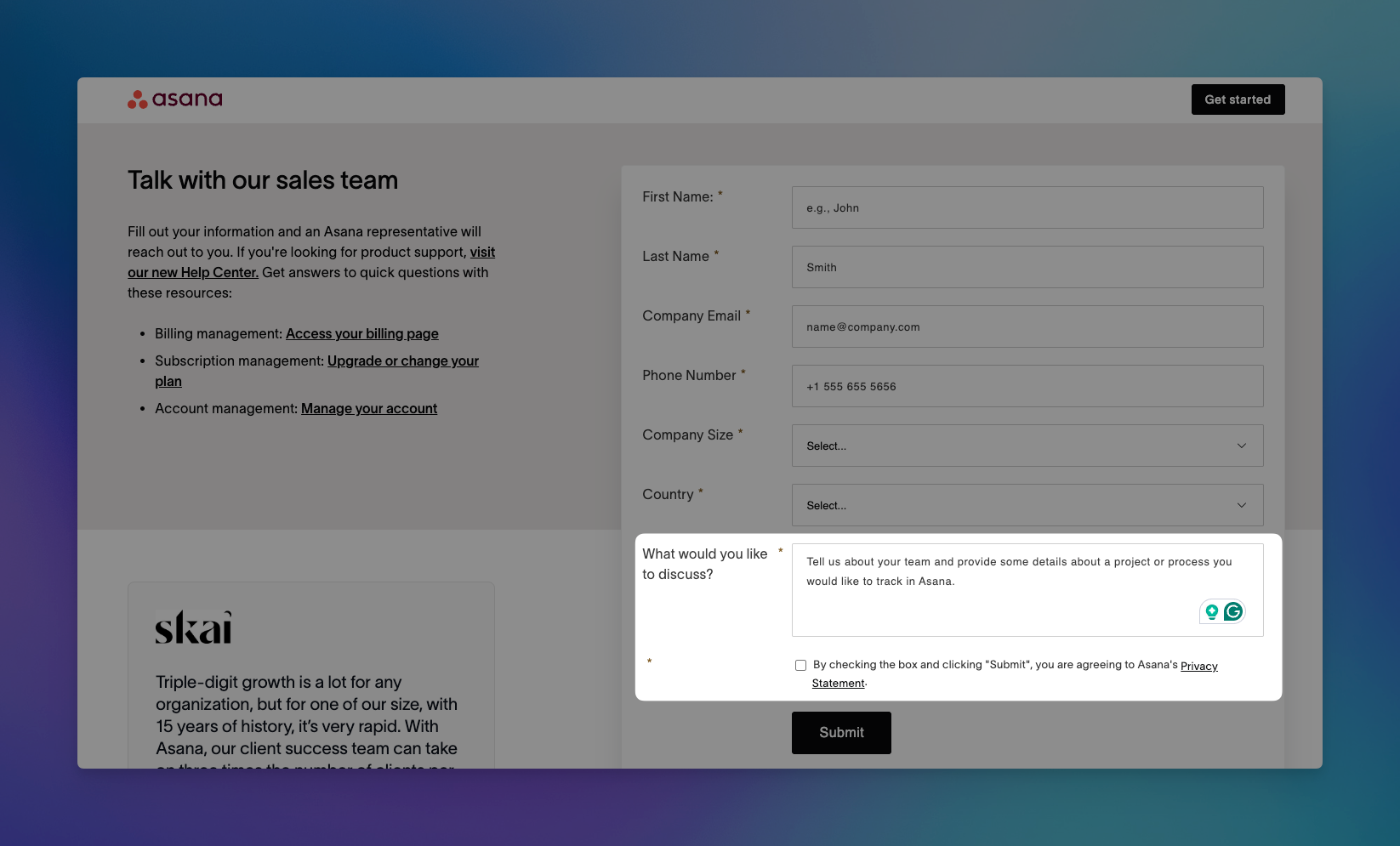
Contact us/Schedule a demo form on your website
